Ijraset Journal For Research in Applied Science and Engineering Technology
- Home / Ijraset
- On This Page
- Abstract
- Introduction
- Conclusion
- References
- Copyright
Rethinking Interior Spaces for Work from Amidst the Pandemic
Authors: Anshuman Dubey, Vanshika Jain, Mehak Chhabra
DOI Link: https://doi.org/10.22214/ijraset.2022.40279
Certificate: View Certificate
Abstract
Amidst the Covid-19 pandemic, people refrained from going out and started working from home. Millions of employees\' working arrangements have changed, and many may continue to work from home in some form for the foreseeable future. This research paper addresses the everyday challenges people face while working from home. To address the lack of workspace, people formed a separate working area or an integrated space with the habitable rooms. Spending the maximum amount of time indoors impacted them psychologically. Hence, there is a need to re-design the current workspace for a better lifestyle. The study attempts to establish a relationship between habitable spaces and work areas in residence.
Introduction
I. BACKGROUND
During the corona-virus disease 2019 pandemic, work from home (WFH) caused significant issues for everyone's health (physical and mental wellbeing) and productivity. For many people, being confined to their homes has eliminated much of their physical activity and constant synchronous action previously built in their day. People are spending their maximum amount of time indoors. This work environment impacts them psychologically, which affects their work efficiency; hence there is a need to design or adjust the current work environment for a better lifestyle.
Overlapping of the personal and the work environment creates a disbalance. The environment at home can be a source of many distractions such as chores, noise, and many others, making it difficult to focus on the task at hand, contributing to reduced productivity. According to a global survey of 12,000 employees, managers, HR leaders, and C-level executives conducted by tech giant Oracle, 89 percent of those aged 22 to 25 and 83 percent of those aged 26 to 37 said they experienced more stress and anxiety this year than the previous year as work issues spilled over into personal life due to a lack of boundaries (Oracle and Workplace Intelligence, 2020).
In 2020, Nicholas Bloom, an economics professor at Stanford University, says, it's a significant concern for younger workers who don't have peace at home because bosses just expect you to get on with it. He raises a concern whether you can work if you don't have any space.
This research identifies characteristics that affect worker’s physical and mental health while working from home and lays the foundation for promoting a positive workplace environment effectively by recommending related solutions.
The context of behaviour and reactions is the surrounding environment. Our moods and behaviours are only relevant if they are comprehended in the context of their surroundings. As a result, the relationship between the physical environment and behaviour is complex and intertwined. In her recently published book, Interior Design & Beyond, Mary V. Knackstedt discusses how planned environments influence human behaviour (Walid Abdel Moneim Abdel Kader, 2019). This paper aims to answer how interiors of a habitable room and communal areas in residence can be enhanced to address the emergence of workspaces at home.
II. METHODOLOGY
This paper aims to recommend strategies for enhancing the interior spaces for work from home amidst the pandemic. The objective is to explore the environmental stimuli and their psychological effects, majorly on 18-37 years old. The study explores the workplace interior design and spatial organisation of a habitable space, to establish a relationship between the two. The research majorly focuses on the following environmental stimuli: light, colour, spatial organisation, acoustic and ergonomics to understand the workplace design with context to productivity and mental health of an individual.
Since the subject is fairly new, there is no pre-defined data bank, and research is still exploratory. The psychological analysis is subjective and cannot be ascertained for a particular individual. Further, a bigger sample size could be considered for future research.
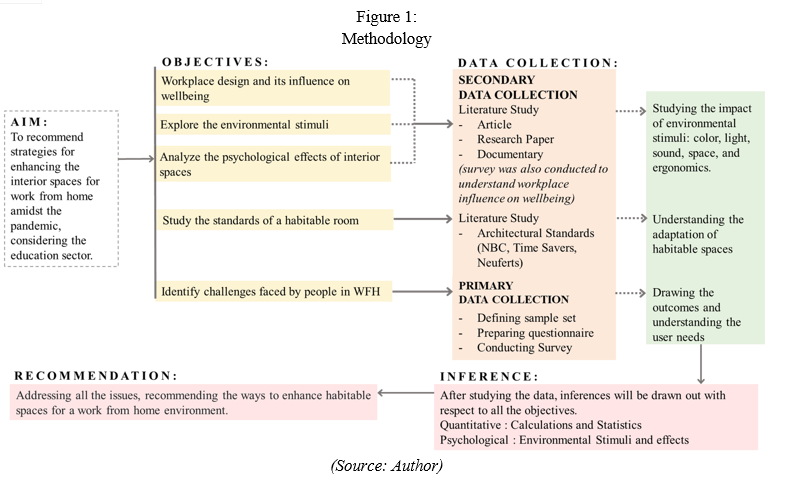
Survey: A survey was conducted to establish the need for the study and understand the challenges people face during work from home amidst the pandemic. Respondents were asked demographic questions, lifestyle and home environment aspects, occupational environmental factors, and home office environmental factors, as well as information about primary dependent variables such as work performance, physical and mental well-being. The information presented here focuses on factors associated with changes in physical and mental well-being, as well as data related to the impact on work performance.
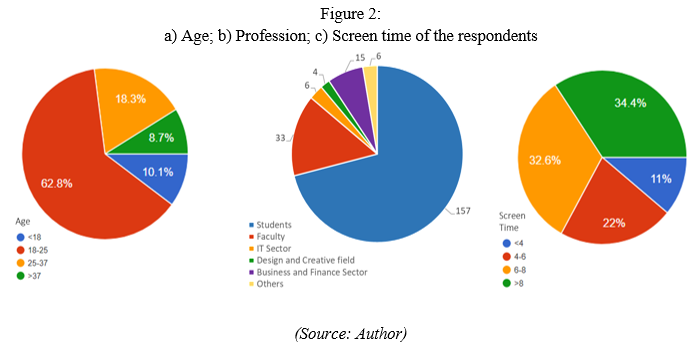
A majority (81.1%) of the respondents belong to the 18-37-year-old age group and spend more than 8 hours in front of the screen. Out of the 218 respondents, 187 (85.7%; 154: students, 33: faculty) belonged to Academic background, 6 (2.75%) were from IT Sector, 15 (6.8%) were from the Business and Finance Sector, 4 (1.8%) belonged to Design, and Creative field, 6 (2.75%) were from others.
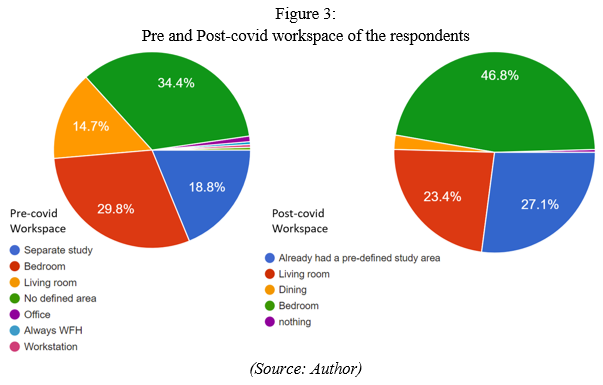
34.4.% of the respondents did not have any defined work space before covid. 46.8% and 23.4% of the respondents converted their bedroom and living room as work/study areas during the pandemic, respectively.
A. Influence of Workplace Design on an Individual’s Performance and Wellbeing
67% of the respondents believe that workplace design impacts work efficiency.
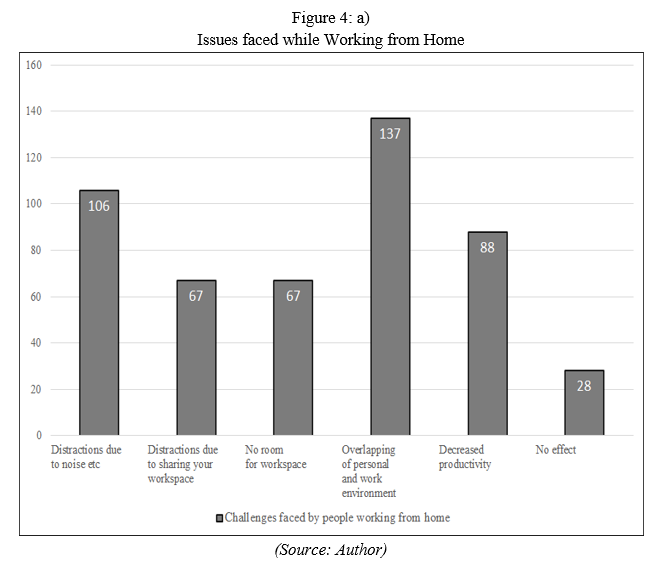
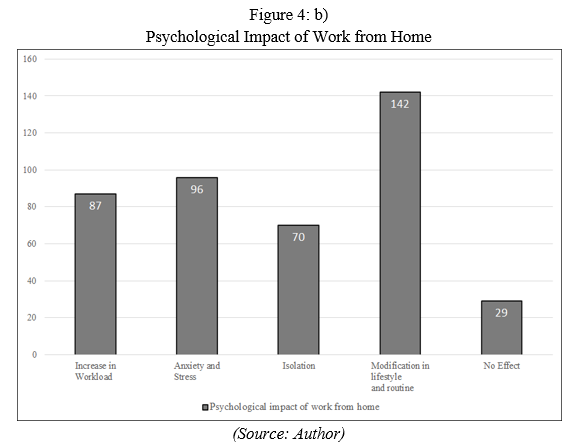
Overlapping personal and work life and disturbance due to background noise were highly rated issues people faced in work from home. Other than productivity, modification in lifestyle and routine followed by anxiety and stress has affected people psychologically.
B. Impact of Various Physical Factors of the Workplace
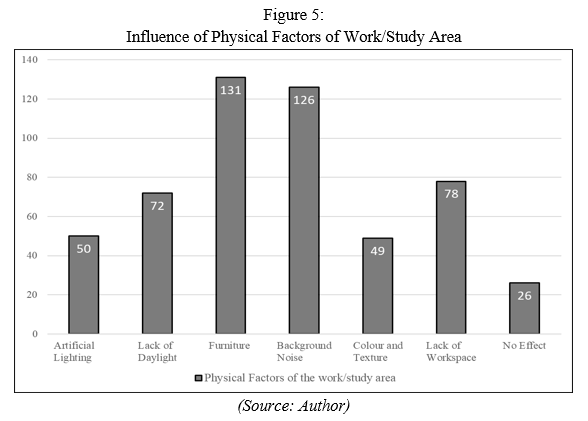
As shown in fig. 5, the effect of physical factors on productivity and wellbeing according to highest to lowest rank were furniture for long working hours, distractions due to background noise, lack of space, lack of daylight, artificial light and colour and texture. The majority of the people with screen time of more than 8 hours develop backaches and neck pain due to inappropriate furniture.
C. Workplace Design and Environmental Stimuli
- Workplace Interior Design and its Influence on Wellbeing and Productivity: Interior design is “the art and science of understanding people’s behaviour to create functional spaces within a building through creative and technical solutions.” (El-Zeiny & Rasha Mahmud, 2018). Poor workplace design is linked to lower performance and higher stress levels (Amble, 2005). The architects of Gensler (2005) conducted a survey of 200 UK business managers showed that an improved workplace would boost employee productivity by 19 per cent.
- Environmental Stimuli and their Impact on Interior Spaces
a. Lighting: Lighting plays a vital role in determining the right ambience of a work area. While designing a workspace, several factors should be considered, such as the illuminance of light, the position of the window and the artificial light source to avoid glare on the working plane.
- Illuminance: Lamps should have limited glare, e.g., through recessed ceiling grid luminaires (Peter Neufert, 2019). An average horizontal illuminance for the task area, as per IS 3646 (Part I) is 300-500-750, depending on the criticality of the task, and the ambient conditions (National Lighting Code, 2010).
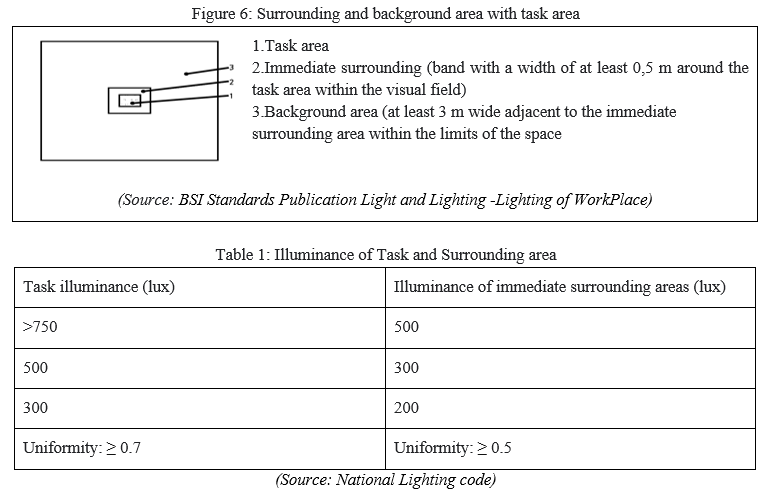
- Glare, Surface Reflectance and Position of Light: The view to the screen should be parallel to the window facade and to light bands, with the screen if possible in-between (Peter Neufert, 2019). All furniture in the immediate vicinity and matt surfaces should have a coefficient of reflection of 20-50% and approx.: ceiling 70%, walls 50%, partitions 20-50%) respectively (Peter Neufert, 2019).
- Colour Rendering Index (CRI): “Colour Rendering Index (CRI) is a measure of the degree to which the colours of surfaces illuminated by a given light source conform to those of the same surfaces under a reference illuminant.” (Unit: Ra) (National Lighting Code, 2010). In modern offices, and as per current international guidelines, lamps with a Ra > 80 are recommended.
- Further Development in Artificial Lighting: Light Gestures is a technical prototype for emerging gesture tracking technologies to invite more natural interactions between an individual and light (Everyday Experiments- Light Gestures, 2020).
- Fenestration and Daylighting: Daylight factor for the study area should be 1.9. Taller windows allow more light in, while wider windows provide for better light distribution. However, a number of small windows properly positioned will give better distribution of illumination than a single large window (National Lighting Code, 2010).
- Psychological Effects of Lighting in Interior Spaces: Lighting quality is related to objectives like enhancing the performance of relevant tasks, creating specific impressions, and ensuring visual comfort. Poor lighting, such as excessive or inadequate light, can cause fatigue, drowsiness, nausea, and eye irritation (Ruzena Kralikova, 2016).
b. Colour: Colour in the workplace has a substantial impact on mood, physiology, well-being, and work-related outcomes. There were both consistent and contradictory results found. Individual differences in culture, gender, age, and background may influence workplace colour perception and colour preferences. The significance of colours influences emotional responses to colour. White is the most prominent and favoured neutral colour for the workplace, yet studies reveal that white walls might appear dull and uninteresting depending on the job type. Green is associated with relaxation and happiness and elicits the most pleasant emotional responses. A cross-cultural study discovered that working in a colourful setting improves one's emotions. A cross-cultural study discovered that working in a colourful setting improves one's emotional status. Visual complexity in a red or colourful setting stimulates and overburdens the brain. The colour red improves cognitive task performance. Blue depicts a lethargic and sleepy impact, yet it also improves creative task performance. Neutral colours, cool blue colours, and a combination of warm and cold colours can boost productivity (Nattha Savavibool, 2018).
c. Acoustics: Role of Sound: Acoustic Comfort means an environment that provides speech intelligibility, speech privacy, low distractions, good sound quality. Noise levels in residential areas are 60-80 db, whereas Optimum range is 45-55 db (IS Code 1952, 1960).
- Conventional Method: Conventional noise barriers like furniture, panel noise barriers (wood, wool, foam.), floor or ceiling finishes (fabric or wood) have the ability to reduce noise by 20-55 db. (20db average sound reduction by 12-5-mm fibreboard to 55db reduction by 40-cm brickwork, plastered) (IS Code 1952, 1960).
- Sound Cancellation Devices: Sound-cancelling technologies use a "phase cancellation" process. This technique takes a sound wave and simply adds its inverse, reducing the sound to near silence in the process. Sound Bubble incorporates this technology. Sound Bubble is a collaborative experiment between SPACE 10 and IKEA, which creates a silence zone around the user. Using a tablet, the experiment would allow you to scan your room and create a zone of localised silence in any given area (Everyday Experiments – Sound Bubble, 2021).
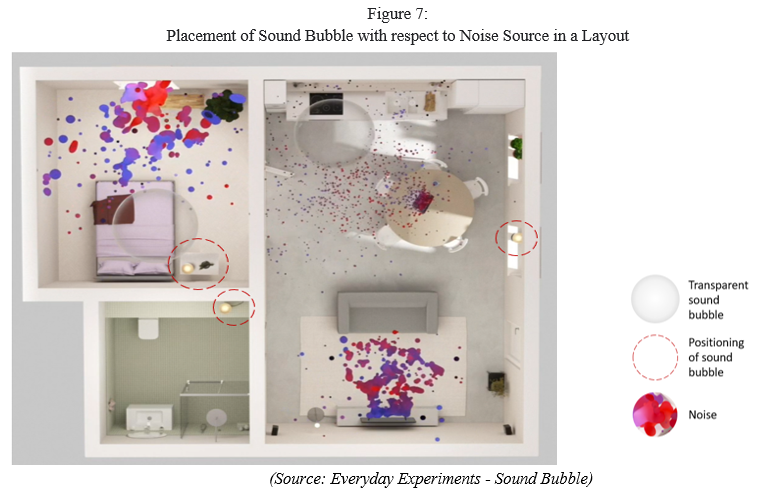
d. Ergonomics: Ergonomics is a science focused on the study of human fit, and decreased fatigue and discomfort through product design (Scott, Openshaw, Erin Taylor, 2006).
- Workstation and Posture: Furniture is such that it fits the individual’s requirements and the criticality of the task. The types of workstations are sitting (height range: 60-78cm) and standing (height range 72-110cm) workstations. Chairs should provide substantial back support and maintain the 90-90-90-degree placement for the elbow, hip, and knee joints, respectively. The variable height of the chair ranges from 42-54cm (Peter Neufert, 2019). The S-shaped posture of the spine while maintaining more than 40cm distance from the screen (L.P. Singh, 2020).
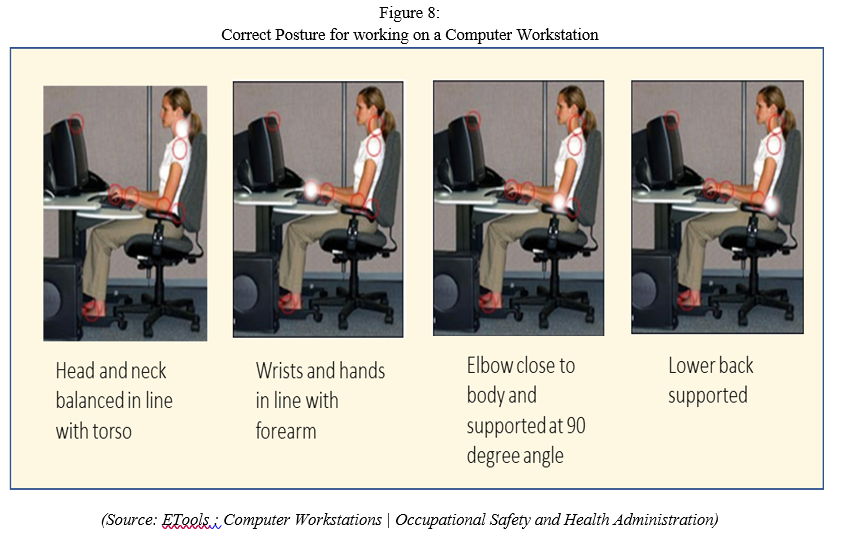
- Psychological Effects of Ergonomics in Interior Spaces: Ergonomic related issues include workstation design, MSD, monotony and boredom, anxiety/stress, disturbance/discontinuity/ lack of concentration (L.P. Singh, 2020).
III. SPATIAL ORGANISATION AND STANDARD HABITABLE SPACE
A. How and Why is Spatial Organisation Important?
Spatial organisation determines the interior circulation strategy, furniture placement, location of doors and windows, considering other factors for functional efficiency in a space (Ching, Francis DK, 2007).
B. Concept of Space Within Space
A smaller space can be enclosed within a larger space. While the continuity between the space can be understood, the smaller space depends on its relationship to the environment. The understanding of spatial relationships clears distinction in size (Ching, Francis DK, 2007).
C. Standard Habitable Space in a Residence
Types of habitable spaces in a residence: Living Room, Drawing Room, and Bedroom (General Building Requirements, MOHUA, 2016)
Table 2: Minimum Size and Width Dimensions of Different Components of Residential Premises
|
Sl.No. |
Components of building |
Min. req. for plot upto 50 sq.m. |
Min. req. for plots above 50 sq.m |
|
1 |
Habitable Room |
Area 7.50sq. m. Width 2.10 m. Height 2.75 m. |
Area 9.50sq. m. Width 2.40 m. Height 2.75 m. |
(Source: General Building Requirements MOHUA)
IV. CHALLENGES FACED BY PEOPLE IN WORK FROM HOME
Work life imbalance, psychological distress (burnout and anxiety), modification in lifestyle and routine (sleeping pattern) and social isolation affected productivity and wellbeing (Rohilla, P., Garg, R. & Chandiramani, K, 2021).
A. Work Life Balance
According to Kirchmeyer (2000), work-life balance is “getting satisfying experiences in all life domains, and doing so requires personal resources such as energy, time, and commitment to be well distributed across domains.” (Rohilla, P., Garg, R. & Chandiramani, K, 2021).
Work from home has an impact on work-life balance in the following ways:
- Work and home commitments overlapping
- Varying degrees of production
- Difficulty meeting deadlines
- Travel constraints and remote working
- Working in a remote location
- A communication chasm exists throughout the corporation.
The lack of physical borders between the two otherwise distinct worlds has resulted in "role blurring," which is defined as "the sensation of confusion or trouble distinguishing one's work from one's family roles."
B. Psychological Effects
Psychological effects of working from home are elaborate in the form of Burnout, Stress, Isolation and anxiety due to no engagement with colleagues. Findings from the survey conducted suggests that anxiety and isolation are the second highest rated issues faced by people while working from home, amidst the pandemic.
C. Lifestyle Changes
Modification in lifestyle such as change in routine (eating, getting up, sleeping pattern), restrictive social relationships, time management, and co-managing the domestic responsibilities along with work, were recorded as the most affecting aspects by respondents.
D. Social Life
Pandemic came with the restrictions and it left people caged in their homes. This developed a sense of loneliness and social isolation amongst the people and is recorded as the greatest downside of the pandemic (Rohilla, P., Garg, R. & Chandiramani, K, 2021).
V. RESULTS AND RECOMMENDATIONS
After analysing the data collected via survey and research, recommendations are drawn in two categories:
- An optimum area of a workstation is calculated which supports the work from home requirements of an individual,
- Recommendations for an efficient work space design are drawn as per categorised time of usage and type of occupation.
A. Calculation of optimum Area for a Workstation
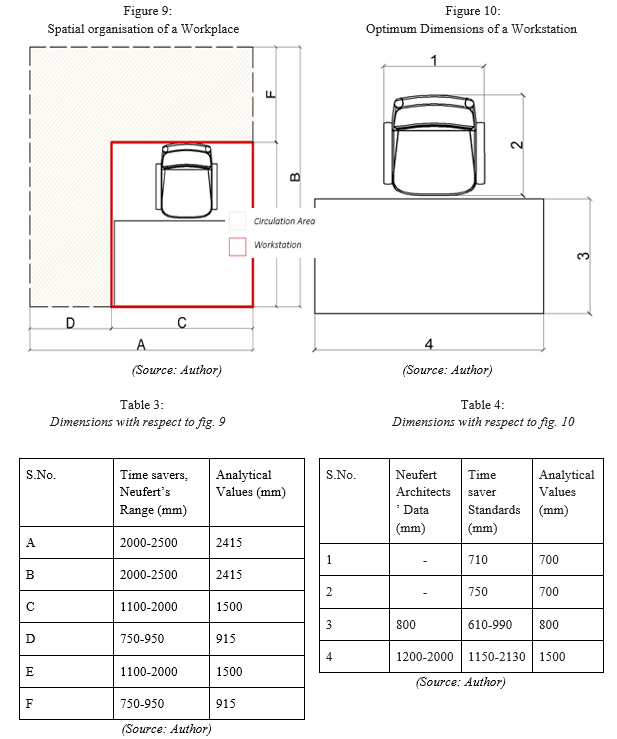
- Calculated Optimum Workstation Area for work from home: 2.25 sq.m.
- Calculated Total Area of the Workplace = workstation + circulation area: 5.9 sq.m.
An optimum workplace area of 5.9 sq.m (including circulation area) is to be added to the standard area of a habitable room for an efficient work area.
VI. RECOMMENDATIONS FOR AN EFFICIENT WORKPLACE
As per the survey analysis, the recommendations for the following categories are drawn:
- Academic Background: Out of 218 respondents, 187 ((85.7%) belonged to Academic background. They are broadly categorised as students (154) and faculty (33).
a. Student: According to the survey, the challenges faced by the majority of students are overlapping personal and work environments and distraction due to noise. Based on the screen time they were further listed under 3 categories, i.e., less than 4, 4-8 hours more than 8 hours. The students working for less than 4 hours belong to the age group of under 18 years and are in school. A foldable workstation with space for a writing pad is proposed for a space efficient working environment. In addition to the setup, a bookshelf shall be installed, depending upon the requirements of the individual. The category of 4-8 hours includes students from the age group of 18-25 pursuing graduation. To address the issue of noise, a working pod shall provide for a distraction-free work environment. Working for more than 8 hours in a work pod can result in monotony and boredom, hence, an ergonomic chair with a table workstation setup is suggested. The psychological issue faced by the individuals is an increase in stress and anxiety levels. Placing a planter near the workspace alleviates anxiety. Walls of vibrant colours (for example, red and yellow) balanced with neutral colours (measure: white, beige) to keep the mind active and away from distractions.
b. Faculty: According to the survey, the highest rated issue is overlapping personal and work environments. A working pod acts as a room within a room. For 4-8 hours, a working pod shall provide a work environment void of distractions. For more than 8 hours, a foldable workstation with enough space for a writing pad is proposed for a space efficient setup. Neutral wall colours (example: beige, white) to keep the mind away from distractions.
2. Business and Finance Sector: The recorded screen time of the individuals is more than 8 hours and the major problem faced is the overlap in the personal and work environments. The respondents did not have a defined work space pre-covid and used a bed table or dining table for work purposes. On the basis of the screen time; for 4-8 hours, to provide a separate work environment, a working pod shall provide a distraction-free environment. A foldable workstation with storage space is suggested for more than 8 hours. For long working hours, neutral wall colour with contrasting cool colours (example: blue) to stay focused and away from distractions and relaxed.
3. IT Sector: In line with the survey, distraction due to background noise is the major challenge faced and the recorded time in front of a screen is more than 8 hours. To counter the problem of background noise, the study suggests an acoustically treated working pod with an ergonomic chair provides a distraction-free work environment.
4. Design and Creative Field: The screen time is a minimum of 6 hours and more than 8 hours for 75% of the respondents. Working from home caused a significant reduction in productivity levels of individuals. Psychologists state that the outside view from the workspace inspires the brain and boosts productivity. A table workstation setup with storage space and an ergonomic chair for long working hours is recommended. Avoiding plain and uninteresting walls, a visual complexity like textured/patterned walls, murals, paintings should be incorporated around the work area, to keep the mind in an active state.
a. General recommendations: This research paper elaborates the common challenges (in context of spatial organisation as well as psychological) faced by people while transitioning to the virtual medium of communication. Environmental factors should be considered to create an optimum work environment in a habitable room. Adequate lighting (300-500-750 lux, depending upon the criticality of the task) is recommended in the workspace. Conventional acoustical treatment (example: fabric/foam panels, soft furnishings) or sound cancellation devices such as Sound Bubbles are suggested to combat the challenge of disturbance due to background noise. Use of an ergonomic chair for long working hours prevents back and neck aches. The working plane should be placed parallel to the window and light bands to avoid glare.
While the study reveals knowledge of various important elements to consider in supporting the physical and mental well-being of employees while WFH, certain limitations should be addressed in the interpretation and application of these findings:
It is crucial to highlight that these data were collected during the early stages of the COVID-19 pandemic; thus, the findings are not intended to accurately replicate traditional WFH situations and may not represent the health status or experiences as the limitations and WFH become more common. While the respondents covered a diverse range of occupational groups, these categories do not represent all job categories, nor do the statistics fully represent all jobs contained within each category. While the data's implications are legitimate, their applicability may not be widely generalizable across different regions or countries and may differ from the experiences of individuals from varied backgrounds.
Out of various combinations, the suggested design solutions are illustrated below for respective occupational categories.
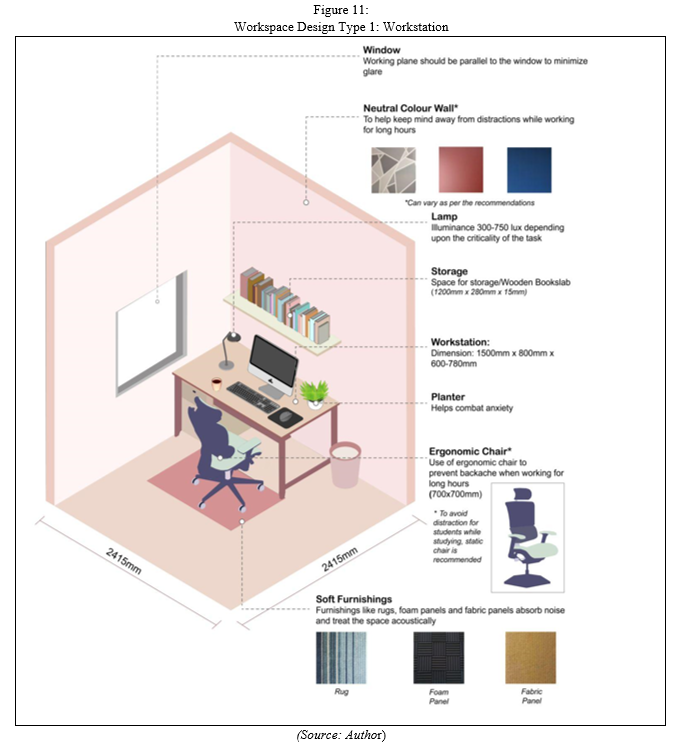
Note: Workplace Design Type 1: Workstation
The area covered by a workstation with and without the circulation area is 5.8 5qm, and 2.2 sq m. respectively. The two types of workstations, depending upon the task, are; sitting (height range: 600mm-780mm) and standing (height range: 720mm-1100mm). An optimum workstation consists of a working desk (1x b: 1500mmx 800mm), an ergonomic chair (1 x b: 700mm x 700mm) and storage space (customizable). This setup is recommended for individuals working for more than 8 hours.
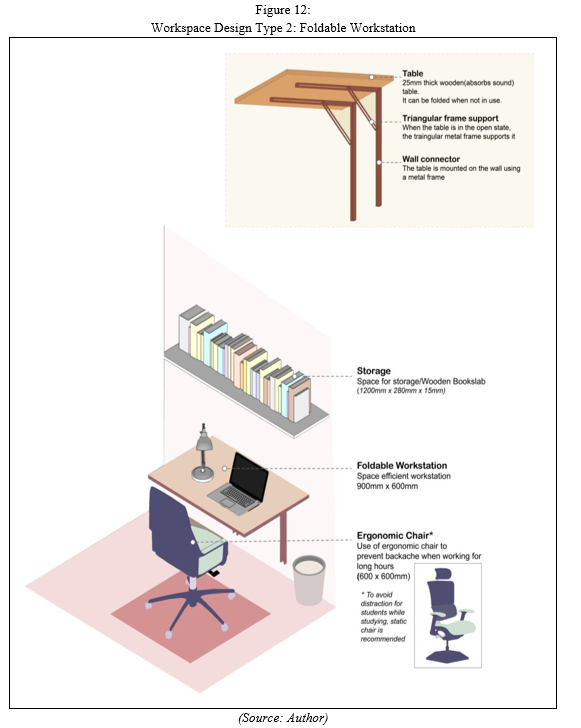
Note: Workspace Design Type 2: Foldable Workstation
The area covered by a foldable workstation with and without the circulation area is 3.8 Sq.m. and 1.1 sq.m. respectively. This is a space efficient alternative to Type 1 (Workstation). These are wall mounted workstations and can be folded when not in use. It is recommended for individuals who do not require a lot of storage space and work area.
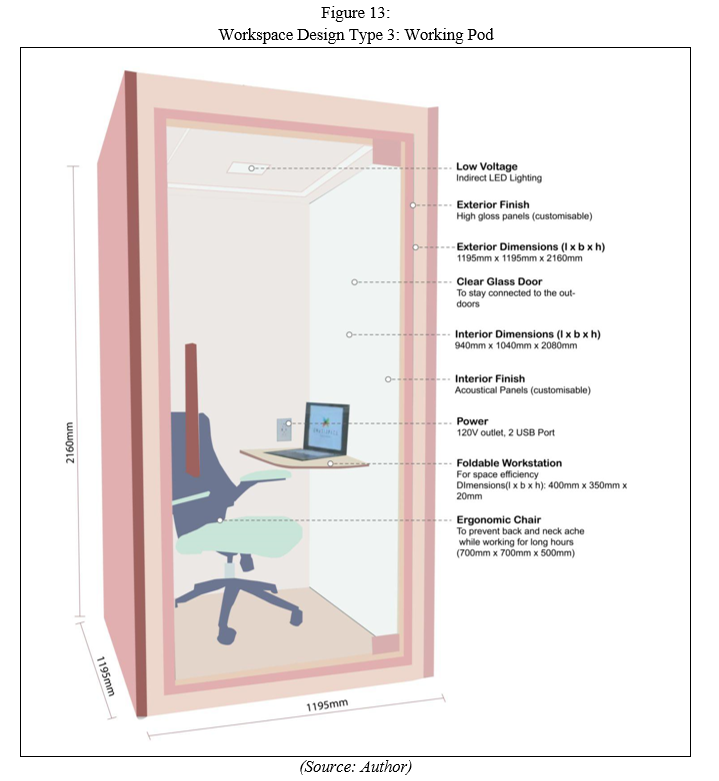
Note: Workspace Design Type 3: Working Pod
A working pod is a room within a room. They generally come with 3-4 sides and a roof on top. Interiors can be treated acoustically to block out noise. The minimum area required is less than 2 sq.m. and hence they are very space efficient. They can be personalised to suit the individual's needs. A working pod is recommended for individuals working for 4-8 hours and are experiencing an overlap in their work and personal life.
Conclusion
Due to the COVID-19 pandemic, many workers had to start working from home abruptly. These workers reported declining overall physical and mental health status and increased new physical and mental health issues. Significant predictors of decreased physical and psychological health status include: reduced physical activity, imbalanced lifestyle, lack of communication with co-workers, social isolation, having a toddler at home. In Addition to the physical and psychological stress, people faced issues related to the physical environment of the workspace. Problems like overlapping personal and work life due to less space, and almost no room for a comfortable workstation were recorded. The analysis of the collected data reveals that beyond the individual lifestyle and home environment, numerous additional considerations related to the work and physical workspace were essential contributors to physical and mental well-being. The study suggests design types for an efficient home working place. The proposed design typologies are broadly classified as per the occupational background, the criticality of the task and usage time of the workspace.
References
[1] Ching, Francis D K, (2007), Architecture: Form, Space, and Order, 3rd Edition, John Wiley Sons. Retrieved from http://rsd2-alert-durden-reading-room.weebly.com/uploads/6/7/1/6/6716949/ching-architecture_form_space_order.pdf [2] El-Zeiny & Rasha Mahmud, 201), Interior Design of Workplace and Performance Relationship: Private Sector Corporations in Egypt, Asian Journal of Environment-Behaviour Studies, Volume 3, doi:10.21834/aje-bs.v3i7.263 [3] ETools : Computer Workstations | Occupational Safety and Health Administration. Retrieved from www.osha.gov, www.osha.gov/etools/computer-workstations. [4] Everyday Experiments — Light Gestures, 2020. Retrieved from www.everydayexperiments.com/light-gestures. [5] Everyday Experiments – Sound bubbles, 2021. Retrieved from www.everydayexperiments.com/sound-bubbles. [6] General Building Requirements, MOHUA. Retrieved from https://mohua.gov.in/upload/uploadfiles/files/Chap-4.pdf [7] IS Code 1952, 1960, Code of practice for sound insulation of non-industrial buildings, Bureau of Indian Standards. Retrieved from https://law.resource.org/pub/in/bis/S03/is.1950.1962.pdf [8] IS Code 3646 Part 1, 1992, Code of practice for Interior Illumination, Bureau of Indian Standards. Retrieved from https://law.resource.org/pub/in/bis/S05/is.3646.1.1992.pdf [9] LP Singh, 2020, Ergonomics for Working from Home during COVID-19 Pandemic, Ergonomics International Journal, vol.4, no.4, doi: 10.23880/eoij-16000246 [10] Naeem Akhtar, Saqib Ali, Muhammad Salman, Asad-Ur- Rehman & Aqsa Ijaz, 2014, Interior Design and Its Impact on Employees\' Productivity in the Telecom Sector, Journal of Asian Business Strategy, Vol.4(6). Retrieved from https://www.academia.edu/8995487/Interior_Design_and_its_Impact_on_of_Employees_Productivity_in_Telecom_Sector_Pakistan4 [11] National Lighting Code, 2010, Bureau of Indian Standards. Retrieved from https://law.resource.org/pub/in/bis/S05/is.sp.72.2010.pdf [12] Nattha Savavibool, 2018, The Effects of Colour in Work Environment: A Systematic Review, Asian Journal of Behaviour Studies, doi: 10.21834/ajbes.v3i13.152 [13] Nicholas Bloom, 2020, How Working from Home Works Out, Stanford Institute of Economic Policy Research. Retrieved from https://siepr.stanford.edu/publications/policy-brief/how-working-home-works-out [14] Oracle, Workplace Intelligence, 2020 (AI@Work Study 2020 as Uncertainty Remains, Anxiety and Stress Reach a Tipping Point at Work Artificial Intelligence Fills the Gaps in Workplace Mental Health Support). Retrieved from https://www.oracle.com/a/ocom/docs/oracle-hcm-ai-at-work.pdf [15] Peter Neufert, 2019, Neufert Architects’ Data Fourth Edition, Wiley Blackwell. Retrieved from https://byarchlens.com/wp-content/uploads/2020/11/Neufert-4th-edition.pdf [16] Poorva Rohilla, Rashi Garg, Dr. Komal Chandiramani, 2021, Negative effects of work from home culture during the coronavirus pandemic: a gender-based study, International Journal of Indian Psychology, Volume 9, Issue 1, doi: 10.25215/0901.129 [17] Ruzena Kralikova, 2016, Lighting Quality and Its Effects on productivity and Humab Healts, International Journal of Interdisciplinarity in Theory and Practice. doi:10.2507/27th.daaam.proceedings.009 [18] Scott Openshaw, Erin Taylor 2006, Ergonomics and Design Reference Guide, Allsteel. Retrieved from https://ehs.oregonstate.edu/sites/ehs.oregonstate.edu/files/pdf/ergo/ergonomicsanddesignreferenceguidewhitepaper.pdf [19] Technical Committee CEN/TC 169, 2011, Light and Lighting -Lighting of WorkPlace, BSI Standards Publication, BS EN 12464-1:2011. Retrieved from https://www.bsigroup.com/LocalFiles/en-GB/industries-and-sectors/lighting/BSI-general-lighting-brochure.pdf [20] Walid Abdel Moneim Abdel Kader, (20005), Does Design Affect Our Senses, Architecture and Human behaviour. Retrieved from https://scholar.cu.edu.eg/?q=w_moneim/files/architecture_and_human_behavior_colored.pdf
Copyright
Copyright © 2022 Anshuman Dubey, Vanshika Jain, Mehak Chhabra. This is an open access article distributed under the Creative Commons Attribution License, which permits unrestricted use, distribution, and reproduction in any medium, provided the original work is properly cited.

Download Paper
Paper Id : IJRASET40279
Publish Date : 2022-02-09
ISSN : 2321-9653
Publisher Name : IJRASET
DOI Link : Click Here
 Submit Paper Online
Submit Paper Online

